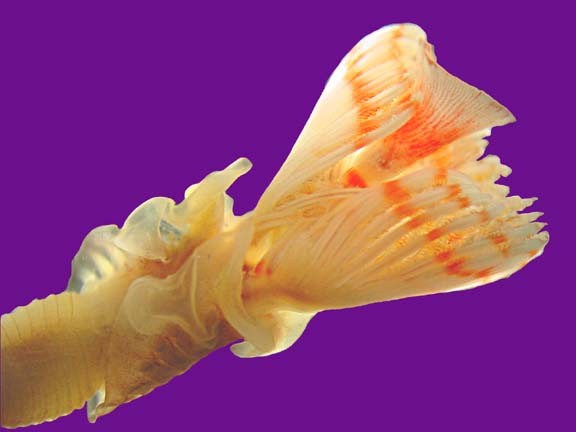Serpula columbiana Johnson, 1901
These sedentary polychaetes live in coiled calcareous tubes that attach to hard surfaces such as rocks, bivalve shells, marina docks, and ships' hulls. International shipping transports populations of tube building worms (such as Serpula) to ports around the world, where they establish new fouling communities. Some Serpula, such as Serpula columbiana, can live in estuaries as well as outer coast and can be found from low intertidal to over 100m in depth.
The bodies of serpulid polychaetes are similar in appearance to sabellid polychaetes. They both possess a crown of plumelike radioles, which function as respiratory and filter-feeding organs. Organic particles in sea water are collected by cilia found along these feathery radioles, and are passed along their length to the animal's mouth for ingestion.
Among differences between the two polychaete families are the presence of an operculum (a "lid" that covers an opening) used by serpulids to plug the opening of their tube when the animal is withdrawn. Sabellids do not possess an operculum. Also, serpulids secrete their white calcareous tubes from ventrally located calcium glands, whereas sabellid worms use secreted mucus to construct tubes made of organic particles and sediment.
Serpula spawn and produce a ciliated, swimming larva called a trochophore.
Recent taxonomic studies (Kupriyanova 1999) have resulted in the separation of our eastern Pacific serpulid, Serpula columbiana from synonymy with Serpula vermicularis. Serpula vermicularis had previously been considered a cosmopolitan species (found throughout the world) that included populations in the Norwegian Sea, the Sea of Japan, and the west coast of North America (among other regions). Morphological differences in these two species allow them to be differentiated into two distinct taxa.

